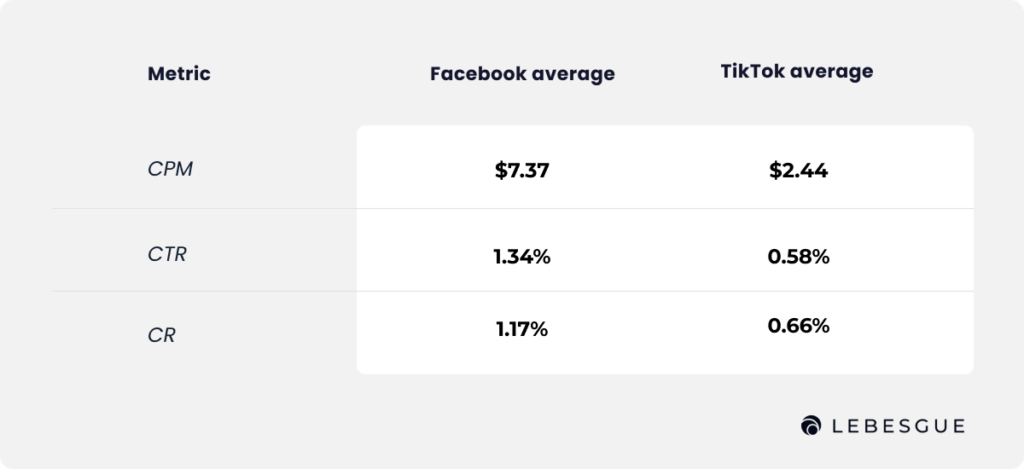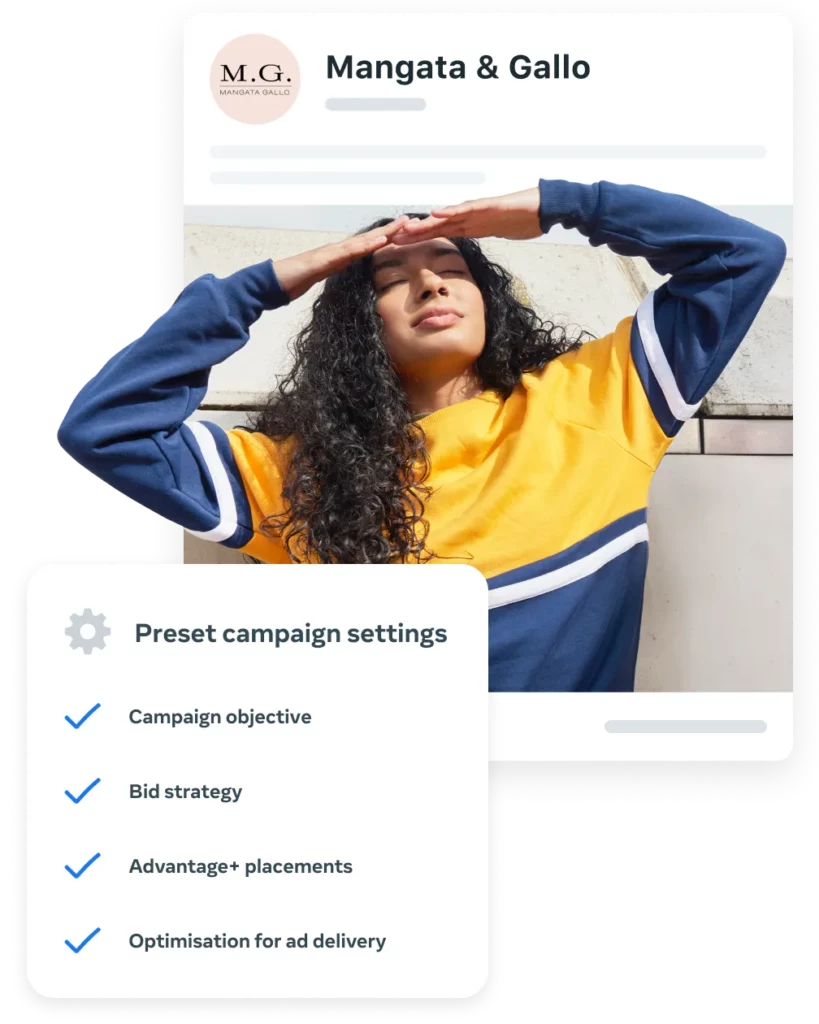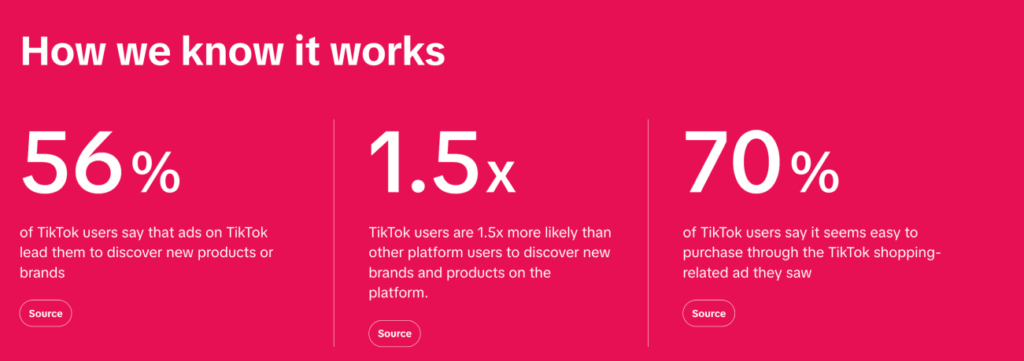Facebook ads vs. TikTok ads. Although both platforms have a lot of interest, the most frequently asked question is: which platform is better for my business? Facebook and TikTok are two of the most popular platforms for running ad campaigns.
Each platform has its own unique features and audience, making it important to understand the differences between the two.
In this blog post, everything is about Facebook ads vs. TikTok ads. We’ll start by talking about the basic differences between Facebook and TikTok ads. As we go deeper into our analysis, we’ll show you the cost and performance comparison.
About Facebook Ads
For e-commerce businesses, Facebook ads (meta ads) are strategic advertising that drives sales, increases brand awareness, and connects with shoppers on Facebook, Instagram, Messenger, and WhatsApp.
Facebook Ads drive e-commerce sales by making products discoverable to a broad but targeted audience. Through advanced targeting, ads reach those most likely to buy, whether they’re discovering new items or returning to items left in their carts. Formats like carousel ads showcase multiple products at once, encouraging impulse buys and cross-selling to boost the average order value.
Facebook ads are particularly effective during high-traffic shopping seasons like Black Friday when e-commerce brands can leverage Facebook’s retargeting and urgency-driven ad options to maximize sales.
With performance tracking tools, businesses can continually refine ads for better results, achieving a higher return on ad spend (ROAS) and making Facebook Ads an efficient channel to drive consistent online sales.
Pros of using Facebook Ads
With billions of active users, Facebook is more than a social platform—it’s a powerful marketing tool for businesses.
Using Facebook Ads, brands can connect with audiences in ways that feel natural and engaging, driving growth and brand awareness. Let’s dive into the top five reasons Facebook Ads are worth considering for your business.
Here are the top five advantages of using Facebook Ads for your business:
- Massive reach
- Precise targeting options
- Variety of engaging ad formats
- Powerful retargeting capabilities
- Real-time analytics and optimization
With these advantages, Facebook Ads provide a structured way for businesses to reach new customers, increase brand awareness, and drive online sales. Whether you’re a small business or an established brand, leveraging Facebook Ads can help you reach your growth goals effectively.
Cons of using Facebook Ads
While Facebook Ads offer numerous benefits, they come with challenges that businesses need to consider. As one of the most widely used advertising platforms, Facebook has its limitations, especially as competition intensifies. Here’s a the top five drawbacks of Facebook Ads that may impact your campaigns:
- Increasing costs and competition
- Ad fatigue and audience saturation
- Strict and complex ad policies
- Privacy and data tracking limitations
- Learning curve and time investment
These challenges highlight some of the complexities of using Facebook Ads. For businesses considering Facebook as part of their advertising strategy, balancing these cons with the platform’s potential benefits is key to achieving a successful campaign.

About TikTok Ads
For e-commerce businesses, TikTok Ads offers a dynamic advertising platform that drives sales, boosts brand awareness, and connects with customers in a creative and engaging way.
TikTok Ads help e-commerce brands showcase their products to a broad, highly engaged audience, particularly Gen Z and millennials. The platform’s algorithm ensures your ads reach users who are most likely to interact with your brand, whether they’re discovering products for the first time or revisiting items they’ve shown interest in.
With formats like In-Feed Ads and Collection Ads, businesses can create eye-catching content that encourages impulse buys and smoothes the path to purchase, all within the TikTok app.
Pros of using TikTok Ads
For businesses aiming to reach a younger, highly engaged audience and drive online sales, TikTok Ads are a powerful tool. With its viral potential and creative ad formats, TikTok allows businesses to connect with customers in fun and authentic ways.
Here’s a closer look at the top five reasons TikTok Ads are worth considering for your e-commerce business.
- Massive and engaged audience
- Creative ad formats
- Precise targeting options
- Viral potential
- Seamless shopping experience
TikTok Ads offer a unique blend of creative flexibility, precise targeting, and engaging content that helps e-commerce businesses connect with a highly active and trend-conscious audience. Whether you’re looking to drive sales, raise brand awareness, or engage with new customers, TikTok Ads provide the tools to help your business succeed in the fast-paced world of social media marketing.
Cons of using TikTok Ads
While TikTok Ads offer a wealth of opportunities for businesses to engage with younger, creative audiences, there are some challenges to consider. As with any advertising platform, it’s important to understand the potential downsides before diving in.
Here are the top five challenges of using TikTok Ads for your e-commerce business:
- Youth-centric audience
- High creative demands
- Limited ad formats
- Costs can be high for small businesses
- Unpredictable ad performance
While TikTok Ads can be highly effective for engaging younger audiences and driving brand awareness, they may not be the right fit for every business. The platform’s creative demands, younger demographic, and potential cost challenges mean it’s crucial to carefully evaluate whether TikTok aligns with your e-commerce goals and audience.
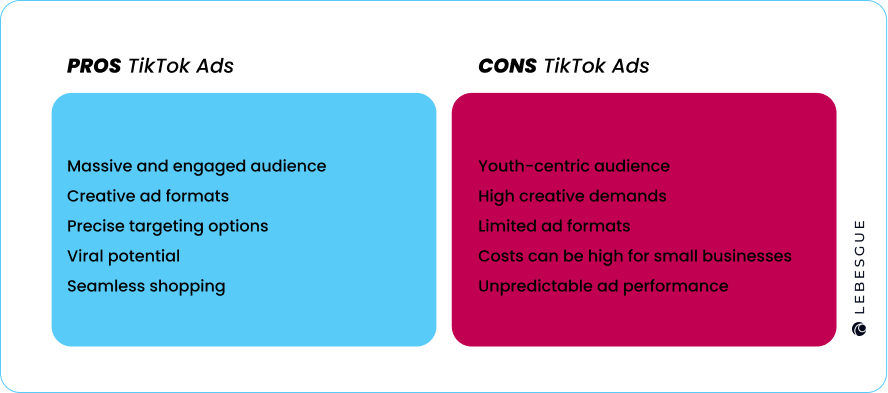
Facebook ads vs. TikTok ads: Basic differences
The primary differences between Facebook and TikTok ads come down to the ad formats, targeting sophistication, and creative focus. Facebook offers a wider variety of ad formats and more advanced targeting, making it ideal for businesses looking to drive conversions and sales with highly refined ad strategies.
On the other hand, TikTok excels in creative, trend-driven content and user engagement, making it a great choice for businesses looking to build brand awareness and connect with younger, trend-savvy audiences.
Let’s begin with exploring Facebook ads vs. TikTok ads format differences.
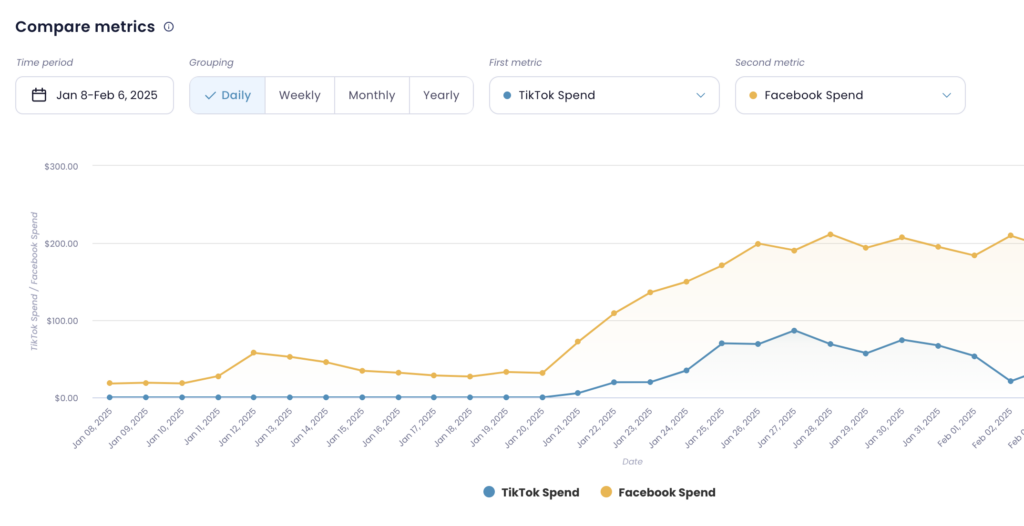
Ad formats
When it comes to ad formats, both Facebook and TikTok offer a wide range of options to choose from.
Facebook offers a variety of ad formats such as image ads, video ads, carousel ads, slideshow ads, and collection ads. These ad formats are designed to fit different business objectives and target different audiences.
For example, photo ads shine when it comes to product showcases. On the other hand, video ads excel at storytelling.
Carousel ads are your go-to for featuring multiple products in a single ad, while slideshow ads effortlessly craft brief, engaging videos.
Lastly, collection ads offer a seamless shopping experience by presenting a cohesive group of products.

TikTok also offers a variety of ad formats such as Native ads, Branded content, and TopView ads. To make your ad more engaging, you can use a video editor to add effects and text overlays.
TikTok’s “Spark ads” are similar to Facebook’s “Engagement ads” in that they are designed to encourage users to engage with the ad by swiping up or commenting.
TikTok also offers campaigns optimized for purchase with “Complete Payment” campaign type. This type of campaign allows businesses to drive conversion by adding a ‘Shop Now’ button to their ads.
The button directs users to a landing page where they can complete a purchase. This is a great approach for e-commerce merchants looking to drive sales.
FACEBOOK ADS FORMAT
- image ads
- video ads
- carousel ads
- collection ads
- flexible ads
TIKTOK ADS FORMAT
- in-feed ads
- top view ads
- collection ads
- dynamic showcase ads
- spark ads
Both platforms offer a wide range of ad formats to choose from. So, it’s important to consider your business objectives and target audience when choosing the right ad format. With the right ad format, you can effectively reach and engage your target audience, and drive conversions.
Ad targeting
Both Facebook and TikTok offer a wide range of targeting options to help businesses reach their desired audience.
Facebook has one of the most advanced targeting options. Businesses can target users based on their demographics, location, interests, behaviors, and connections.
Also, Facebook allows businesses to create Custom Audiences using customer data and retargeting options, without relying on a custom QR code. With Facebook’s Lookalike Audiences feature, businesses can also target users who are similar to their existing customers.
TikTok’s targeting options are not as advanced as Facebook’s, but it still allows businesses to target users based on their demographics, location, interests, and device type.
Also, TikTok allows businesses to create Custom Audiences using customer data and retargeting options. TikTok also offers Interest Targeting which allows businesses to reach users based on their interests.
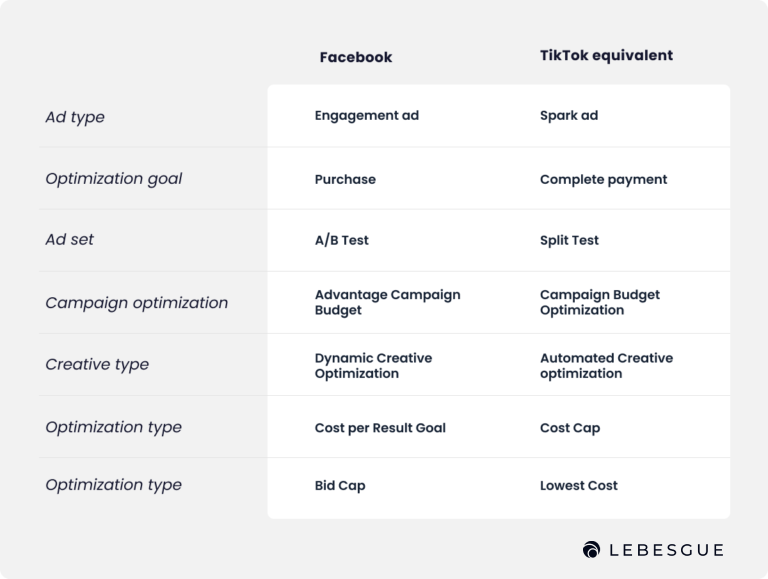
Both platforms allow businesses to target a specific audience by using their data, interests, and behaviors, which is key for improving ad performance.
However, Facebook offers more advanced targeting options and a broader range of audience data and analytics. So, comparing targeting in TikTok ads vs. Facebook ads, Facebook is a winner.
Ad creative
On Facebook, creativity is important, but the expectations are more traditional and polished. Ads are expected to reflect professionalism and clearly communicate the product’s value proposition.
As a result, Facebook is a good fit for businesses that want to display their products in a controlled, structured environment, with ads that might include detailed features, testimonials, or high-quality product images/videos that highlight specific aspects of the offering.
Since Facebook’s audience tends to appreciate clarity and professionalism, businesses can rely on carefully crafted visuals that communicate their brand’s authority and reliability.
TikTok, on the other hand, is designed around raw, authentic, and fun video content. The platform thrives on user-generated content (UGC) and trending challenges, which means that ads that feel too polished or overly promotional can perform poorly. TikTok’s audience is highly attuned to content that feels real and relatable.
For e-commerce businesses, TikTok presents an opportunity to get creative and playful. Brands can leverage popular trends, challenges, or memes to integrate their products into everyday moments.
The key to success on TikTok is creating content that doesn’t feel like a traditional ad but rather blends seamlessly with the user-generated content on the platform.
Facebook Ads are best suited for businesses looking for polished, informative ads that highlight products with a professional tone.
TikTok Ads favor authenticity, engagement, and content that matches the platform’s casual, trend-driven style, making it ideal for businesses that want to embrace creativity and experimentation.
Facebook ads vs. TikTok ads: cost and performance comparison
Now, let’s dive deep into the comparison of the cost and performance of Facebook and TikTok ads. We’ll take a look at the costs associated with each platform and the metrics used to measure the effectiveness of your ads.
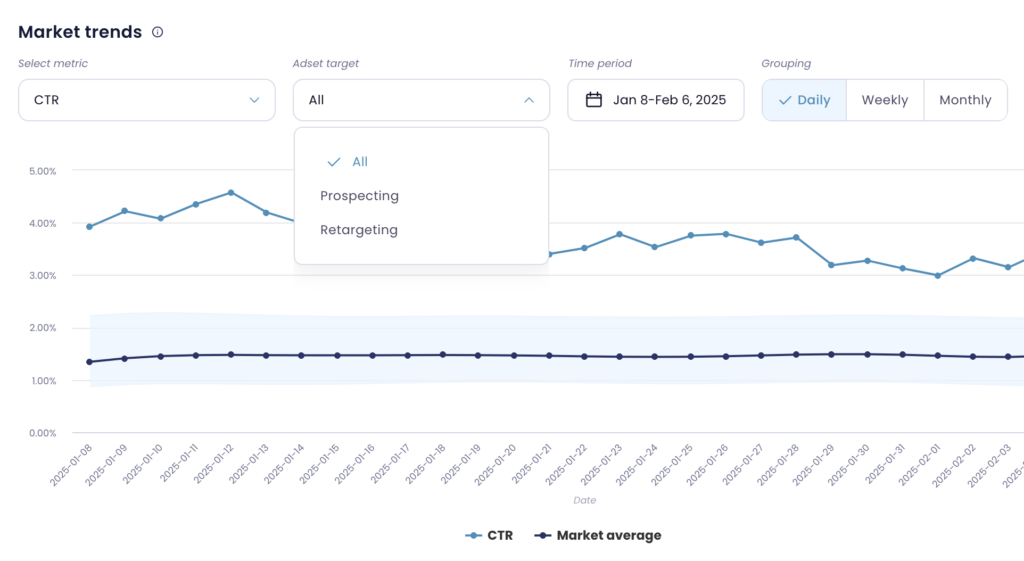
CPM comparison
Advertising on Facebook and TikTok can vary greatly in terms of costs. To give a comparison, we’ll analyze ad costs for a business that is spending between $10,000 and $140,000 on advertising, targets a US audience, follows advertising best practices, and optimizes for purchase (Facebook) or Complete payment (TikTok) events.
Facebook allows businesses to set their own budget for their ad campaigns, and costs can vary depending on the targeting options, ad format, and ad placement.
The average cost per click (CPC) on Facebook is around $0.57, while the average cost per thousand impressions (CPM) is around $7.37.

TikTok’s advertising costs are generally lower than Facebook’s, but they also vary depending on the targeting options, ad format, and ad placement.
The average cost per click (CPC) on TikTok is around $0.51, while the average cost per thousand impressions (CPM) is around $2.44. It’s important to note that while TikTok’s advertising costs may be lower, the platform also has a smaller user base.

Facebook Ads have a higher CPM than TikTok Ads, meaning it costs more to reach 1,000 people on Facebook.
This could be due to Facebook’s broader targeting options and higher competition, especially in established markets. On the other hand, TikTok’s CPM is significantly lower, allowing brands to reach a larger audience at a more cost-effective rate.
So, by comparing Facebook vs. TikTok ads cost, we can say that on Facebook you can expect higher average CPM and CPC than on TikTok.
However, while TikTok’s advertising costs may be lower, you should consider your overall marketing goals and budget, as well as the size of the platform’s user base when deciding which platform to advertise on.
With Lebesgue: Marketing & LTV, you make informed decisions about your advertising budget and optimize your ad campaigns for maximum ROI.
CTR comparison
Comparing Facebook vs. TikTok CTR, Facebook, on average, has a higher link CTR of 1.34% compared to TikTok’s average of around 0.58%.
This means that users are more likely to click on a link in a Facebook ad than a TikTok ad. Facebook’s extensive history and user familiarity create a strong foundation for trust and active engagement with ads on the platform.
Additionally, it’s relatively easier to achieve a high CTR on Facebook through ad copy optimization. With the right optimization, you can achieve a CTR of over 2%.

While Facebook Ads have a higher CTR, this indicates that ads on Facebook are more likely to generate clicks relative to impressions. TikTok’s CTR is slightly lower, suggesting that while TikTok’s lower CPM allows for broader exposure, the engagement might not always convert as well in terms of direct clicks.
However, TikTok tends to keep more of its audience within the platform, which can be beneficial for businesses looking to drive engagement and increase brand awareness.
CR and CAC analysis
Facebook outperforms TikTok when it comes to conversions.
With a 1.17% CR, Facebook users are more likely to take the desired action after clicking an ad. TikTok, however, shows a 0.66% CR, meaning fewer people convert after clicking on an ad.
This could be attributed to TikTok’s focus on creative, trend-driven content, which may not always be optimized for direct conversions but rather for engagement or awareness.

While Facebook Ads are more efficient in terms of conversion and cost per acquisition, TikTok Ads have a higher CAC.
This indicates that although TikTok might provide cheaper impressions, it’s costing more to convert users into customers compared to Facebook. TikTok’s audience may be more engaged with content for entertainment, but the conversion from engagement to purchase might be more difficult.

So in the ad performance comparison between Facebook ads and TikTok ads we can say that:
- Facebook Ads tend to perform better in terms of CTR, CR, and CAC, making it a solid choice for businesses that prioritize direct conversions and a more efficient return on investment.
- TikTok Ads, while offering a lower CPM, have a slightly lower CTR and CR, resulting in a higher CAC. TikTok is better suited for businesses looking to drive brand awareness and engage with a younger, trend-conscious audience, but may require more creative effort to convert that engagement into sales.
When to use Facebook ads?
Facebook Ads are ideal when your goal is to drive conversions, generate sales, and reach a broad yet highly targeted audience.
Here are key scenarios when to use Facebook Ads:
Driving sales and conversions: If you’re looking to turn interest into purchases, Facebook Ads are highly effective due to their robust targeting options. These options let you reach people who are most likely to engage and convert based on past interactions, behavior, and interests.
Retargeting leads: Facebook is perfect for retargeting customers who have already interacted with your brand, such as those who added items to their cart but didn’t complete the purchase. Using Dynamic Product Ads, you can automatically show products that users previously viewed or showed interest in.
Building brand awareness with professional content: If your business relies on polished, professional imagery or videos to showcase products, Facebook Ads work well in delivering high-quality creative to your audience. It’s especially effective for businesses that sell more traditional e-commerce products or services.
So, use Facebook Ads when your primary focus is driving direct conversions, retargeting customers who are already familiar with your brand, or leveraging professional creative to create a polished, high-impact advertising experience.
When to use TikTok ads?
TikTok Ads are best used when your goal is to build brand awareness, engage with a younger audience, and create viral, trend-driven content.
Here are key scenarios when to use TikTok Ads:
Creating buzz and brand awareness: TikTok excels in generating excitement around your brand through creative, organic content. If you want to introduce a new product or campaign and make a big splash quickly, TikTok is the ideal platform to leverage viral trends and influencer partnerships to gain broad exposure.
Targeting a younger demographic: If your target audience is primarily Gen Z or millennials, TikTok is the platform to use. Its user base is younger, and they engage with content in a more authentic, less commercialized way. Brands that align with youth culture and creativity tend to perform well here.
Experimenting with creative and trend-driven content: TikTok Ads thrive on user-generated content (UGC) and content that feels raw, fun, and authentic. If you’re willing to take creative risks and experiment with video formats, including In-Feed Ads and Branded Hashtag Challenges, TikTok offers a unique space to push boundaries and engage users in an entertaining way.
Use TikTok Ads when you want to engage younger audiences, build brand awareness through viral trends, or create authentic, creative content that resonates with users in a more casual and organic way.
Summing Up
In the Facebook vs. TikTok ad debate, it’s clear that each platform has its strengths. Facebook boasts a solid CR and reasonable CAC, while TikTok offers a unique engagement style at a slightly higher cost.
Remember, every business has unique goals. Choose a platform aligning with your specific objectives, whether it’s high conversion, cost-effectiveness, or brand visibility. Customizing your strategy to your business goals ensures a more impactful and successful advertising campaign.
And here is a table with key metric comparison – taking into the account US market market, ad spent between $10k and $150k, and product AOV between $50 and $200.
